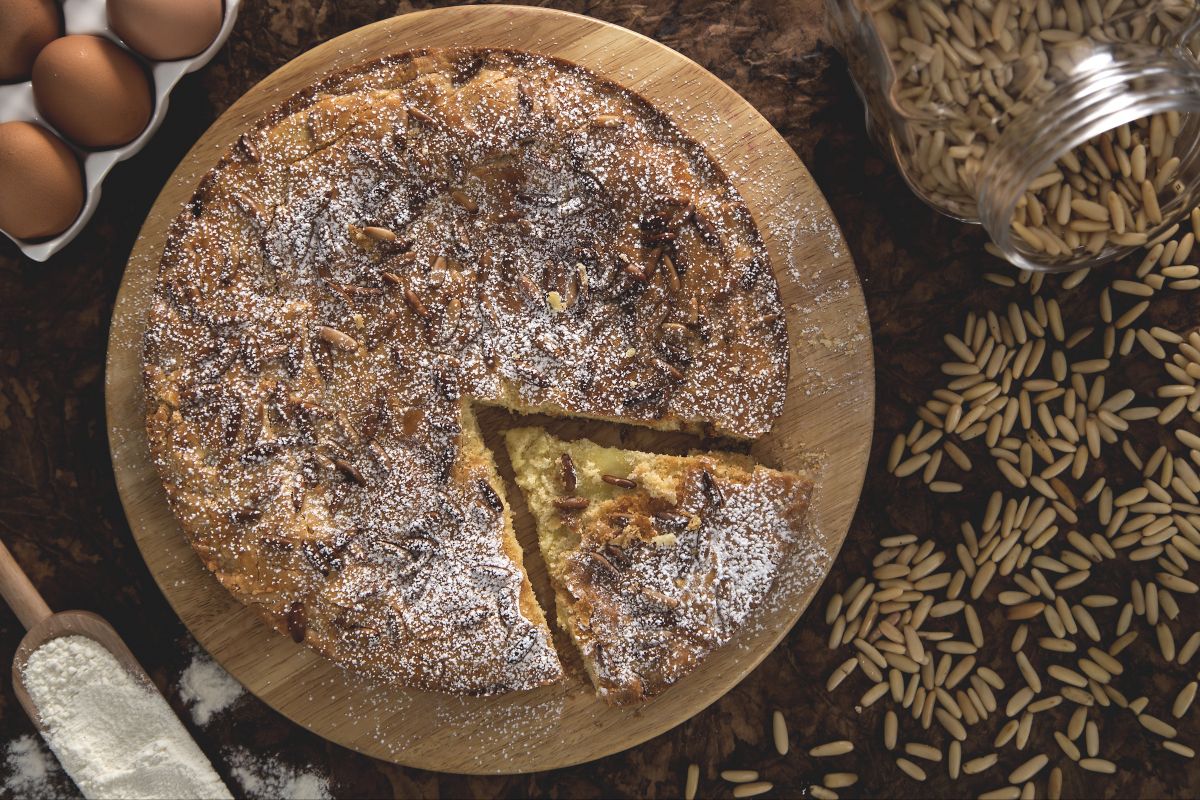Microwave Pesto Lasagna
- Easy
- 45 min

Pinolata really shows off what Tuscany is all about: soft, simple, and full of good stuff from the region. And look, coming from Siena and the Chianti area, this Italian pine nut cake has a moist and tender texture that makes it a favorite. Really really popular at the end of a big meal. What sets it apart? The way it’s built—two layers of pillowy dough with a smooth, creamy filling in between, all topped with a handful of pine nuts right before baking. Folks in Tuscany sometimes add a hint of lemon or vanilla to the filling—pretty simple—and some toss in extra pinoli and raisins for even more bite.
The flavor is mellow but rich. Not too sweet, and every bite gives you those little crunchy surprises from the pine nuts. It’s got that classic feel, no question, but there are plenty of ways to make it your own. That's a big part of what makes this Pinolata recipe so special.
Whether it’s for a weekend get-together or just a regular afternoon, Pinolata is the sort of traditional Italian dessert that fits right in. People in Siena and Chianti love to enjoy it with a small glass of vin santo. Seriously good. It really lifts the flavors and makes the velvety cream inside pop even more. It’s not as heavy as some other cakes, so you get this light, almost delicate finish that keeps you coming back for another slice.
Some compare it to a Torta della Nonna, but this one has its own Tuscan spin—rustic, no frills, and all about those local ingredients. You’ll find that it holds up as both a cozy family treat or something to share when you want to show off some real Tuscan pine nut cake. If you’re into exploring more Italian pastry recipes, pinolata is a great place to start. For real, it gives you a taste of the region’s tradition, and you might end up wanting to try even more sweets from the beautiful hills of Tuscany after just one bite. So go ahead, slice into a piece of this delicious heritage and savor the authentic flavors of Italy.

To prepare the pinolata, start with the cream: in a large saucepan pour the milk 1 and heat it over low heat. Meanwhile, in a small bowl, pour the egg yolks, add the granulated sugar 2 and beat them with a whisk 3.

Then add the flour by sifting it with a sieve 4 and mix again with the whisk to combine the ingredients 5. At this point, when the milk is hot, turn off the heat and pour it gradually over the egg, sugar, and flour mixture using a ladle 6. Add it little by little, continuing to stir with the whisk to avoid lumps.

Strain the cream obtained and pour it into the saucepan where you heated the milk 7; cook the cream over low heat, stirring constantly with a whisk 8 until it comes to a light boil. The cream will be ready when it becomes thick enough to coat a wooden spoon. Then turn off the heat and transfer the cream obtained to a large container 9. Cover with plastic wrap in contact with the surface and set aside at room temperature to cool.

While the cream cools, proceed to prepare the dough. In the bowl of a stand mixer, place the room-temperature butter cut into pieces, pour in the granulated sugar 10 and start beating 11; with the beaters still running, add the egg yolk 12.

When the yolk is incorporated, pour in the whole egg 13 and continue to beat with the beaters; then add the flour and baking powder, previously sifted together, a little at a time, using a spoon 14. Work the mixture until you obtain a smooth and soft dough 15.

Take it out of the stand mixer, work the dough with your hands, and form it into a loaf wrapped with plastic wrap 16. Place it in the refrigerator for about 1 hour until it becomes very cold. After the necessary time, line an 11-inch diameter cake pan with parchment paper 17 (for this procedure, you can consult the Cooking School: how to line a cake pan with parchment paper). Then take the loaf out of the refrigerator and divide it in half: roll out the first half with a rolling pin to create the base of the cake 18 and obtain a disc of the same size as the cake pan and about 0.2 inches thick.

With the help of the rolling pin, unroll the dough disc onto the cake pan 19 and use your hands to perfectly adhere the dough to the bottom 20 and the edges. Then retrieve the cream that has cooled and pour it into the mold using a spatula to spread it evenly over the entire surface 21.

Now you can also roll out the other half of the dough 22 to create the covering disc of the same diameter and thickness as the previous one. With the help of the rolling pin, gently place it over the cream 23 and adhere the edges to the base 24 to close the cake.

In a small bowl, beat the egg with the fresh milk, then brush the surface of the cake using a brush 25. After that, sprinkle the pine nuts 26 to decorate the surface. Then bake the pinolata in a preheated static oven at 350°F for about 40 minutes (if using a convection oven, bake at 320°F for 30-35 minutes). When the cake turns slightly golden on the surface, take it out of the oven 27 and let it cool at room temperature. Then remove the pinolata from the mold, and if you want, sprinkle it with powdered sugar before serving!